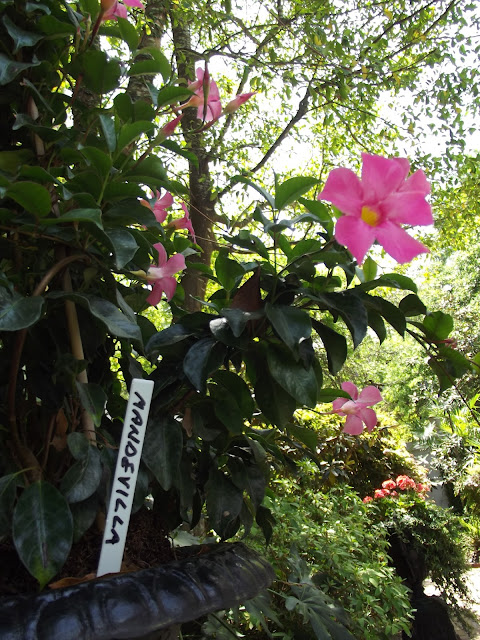Every April,
The Garden Club of Savannah hosts a tour, open to all who want to sneak a peek at the most impressive gardens in the historic district of our charming
Hostess City. These gardens are all private properties, uniquely reflecting the ideals and aesthetics of their owners.
Today we're lucky to look inside at 6 of the 9 gardens featured in the the 2013 North of Gaston Street (NOGS) Tour of Hidden Gardens...
- A Japanese-inspired installation with Dali-esque cedars
- An English garden that reveals the circle of life
- An artist's garden
- A swimming pool-centric paradise
- The most magical secret garden in Savannah
- A simple space that can be captured in a vista
--- --- --- --- --- --- --- --- --- --- --- --- --- --- --- ---
a Japanese-Inspired Rock Garden with a Twist
Confederate Jasmine
frames the back door and creeps along the wrought iron balcony.
These natural columns
are just starting to bloom, intoxicating the early summer air with their smoky floral scent.
In the central courtyard, Dwarfed Blue Atlas Cedars
are the focal point.
The twisted, Dali-esque cedars are complimented by round rock sculptures, Hen & Chicks and Horsetail.
The geometric water feature is flanked by potted devil's backbone, with water hyacinth and
seed oats tucked inside.
Our backdrop: papyrus. Could there be a better choice?
I WANT this Devil's Backbone - I think it is Pedilanthus tithymaloides.
Along
the garden's walled in borders stand Sago Palms and a Hackberry Tree in
the Southwest corner.
There is one Japanese Maple in the Northwest Corner of the
beautiful space.
| --- --- --- --- --- --- --- --- --- --- --- --- --- --- --- --- |
|
|
|
|
|
|
|
|
|
|
|
|
|
|
|
|
|
|
|
|
|
|
|
|
As Lizards Eat Bees in Bright English Gardens
This garden's cascading water feature made the same tinny sound as the geometric water feature from the garden we just saw - both a far cry from the soothing sounds of a babbling brook. Wouldn't you believe the cascades equally measured about 13 inches.
I wonder what could we do to make the sound more sweet..
The name of the game here is annuals, and it is such a stark contrast to the permanent installment we just saw.
You can't miss the unavoidable southern garden feature, the jasmine arch as you walk into this garden.
There is beautiful mirroring in both garden beds, and that's where my admiration ends.
The hyper-intentionality of the design and the obviousness of the gardener's necessity to continuously ensure that the annuals stay inside the confines of that design seem so...imperial.
It looks nice, but I do prefer a more organic and rambling feel to the straight lines and severity of this space.
Despite the design efforts toward decorum, check out the circle of life that happened therein...
--- --- --- --- --- --- --- --- --- --- --- --- --- --- --- ---
Myrtle's Myrtle: The Artist's Garden
As the only surviving plant from the original homeowner, artist Myrtle Jones, the crepe myrtle in the southwest corner of the property on Gaston Street grows old but still looks young.
Its distinguishing mottled bark sheds throughout the year to give the tree a snake-like appearance.
Isn't this seating so Eurofabulous?
Y'all - weren't we just wondering about how to design a water feature correctly?
Well, Frank Lloyd Wright designed this fountain in 1917. He really hit the jackpot.
In the back of the house, the current owner's middle daughter payed tribute to her siblings through her art.
5' tall sculptures cast out of stainless steel are colored with automobile paint selected by the daughter the statue represents...
--- --- --- --- --- --- --- --- --- --- --- --- --- --- --- ---
Mandevilla and the Swimming Pool
Oh to have a swimming pool in Savannah!
If I lived here, I couldn't stop myself from jumping in EVERY DAY.
I was lucky enough to be invited up that spiral staircase, and the inside was just as beautiful as the outside.
The most unique botanical was the mandevilla surrounding the pool.
I would like to see Mandevilla interplanted with one of my favorite ornamentals, Thunbergia - as they look so similar.
One of the fellow NOGS tourists said, "This town is just so charming, I really am mystified by everything about it." This garden captured that sentiment.
--- --- --- --- --- --- --- --- --- --- --- --- --- --- --- ---
The Most Magical Secret Garden I've Ever Seen
The archway is made from trained white yew trees that grow from garden beds interplanted with Sasanqua camellia and blue salvia. The imported French fountains are, without a doubt, the most haunting water feature of this year's garden tour.

Lobelia and chrysanthemum, farfagum, stromanthe and ginger opposite a simple yet lovely little japanese maple that grows beside an old birdgage-turned-moss garden.
Pass the hydrangeas that usher you into the back entrance, and walk through the covered outdoor kitchen space.
The backyard has a nice large green grassed area.
The most beautiful jug water feature, an Italian import, is - again, surrounded by papyrus.
Those columns were the original columns on the house.
Opposite this amazing water feature is a uniquely trellised pear tree.
--- --- --- --- --- --- --- --- --- --- --- --- --- --- --- ---
For the Last Garden...
a simple panorama to enjoy.
That's all, folks!
Next year, the NOGS Tour of Hidden Gardens in Savannah will take place April 25-26, 2014 - that's a Friday and a Saturday.
If you aren't staying with me, check out the Savannah Inns for your accommodations, run by my favorite innkeepers in town!









































